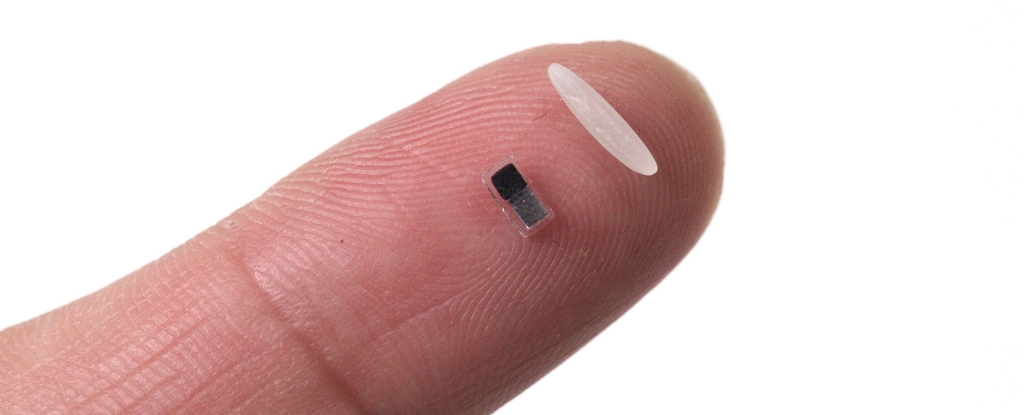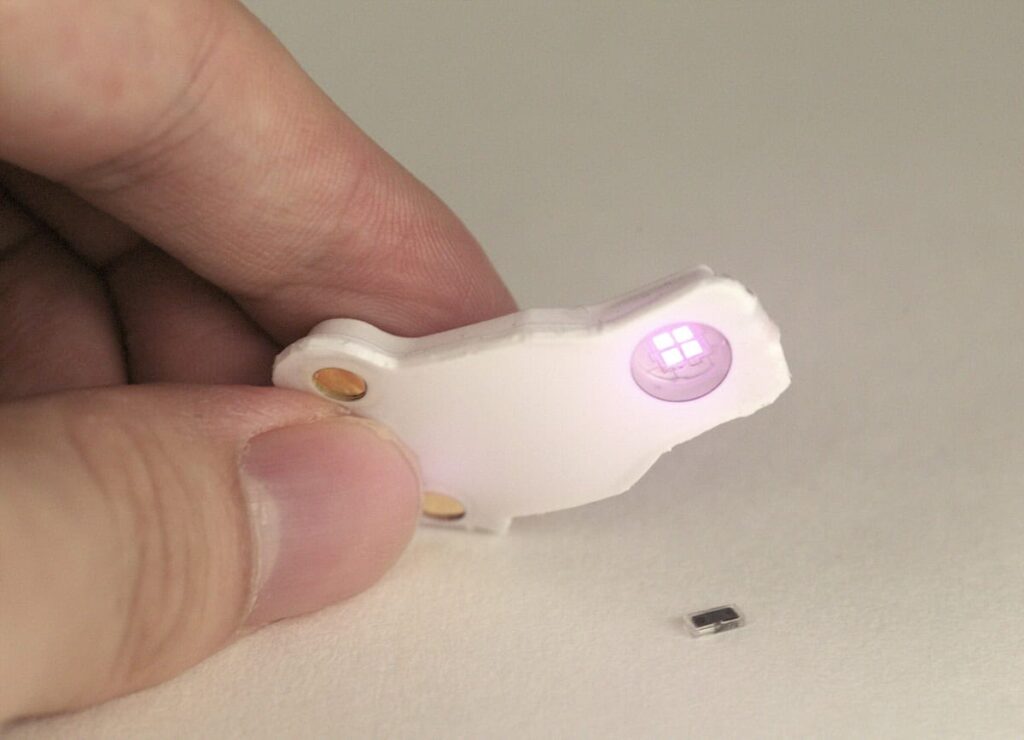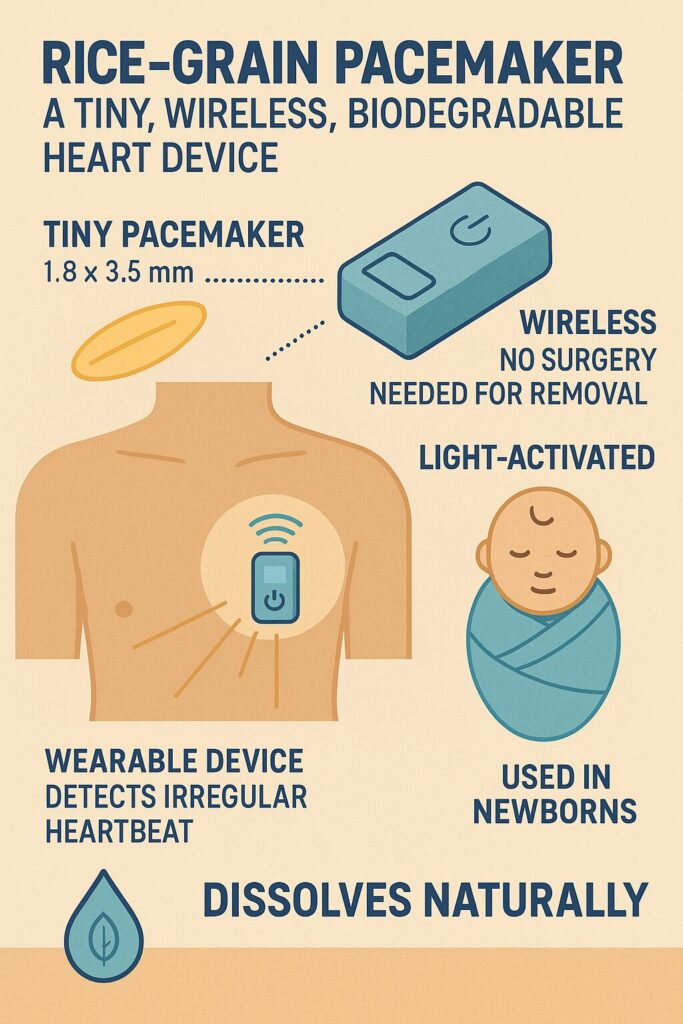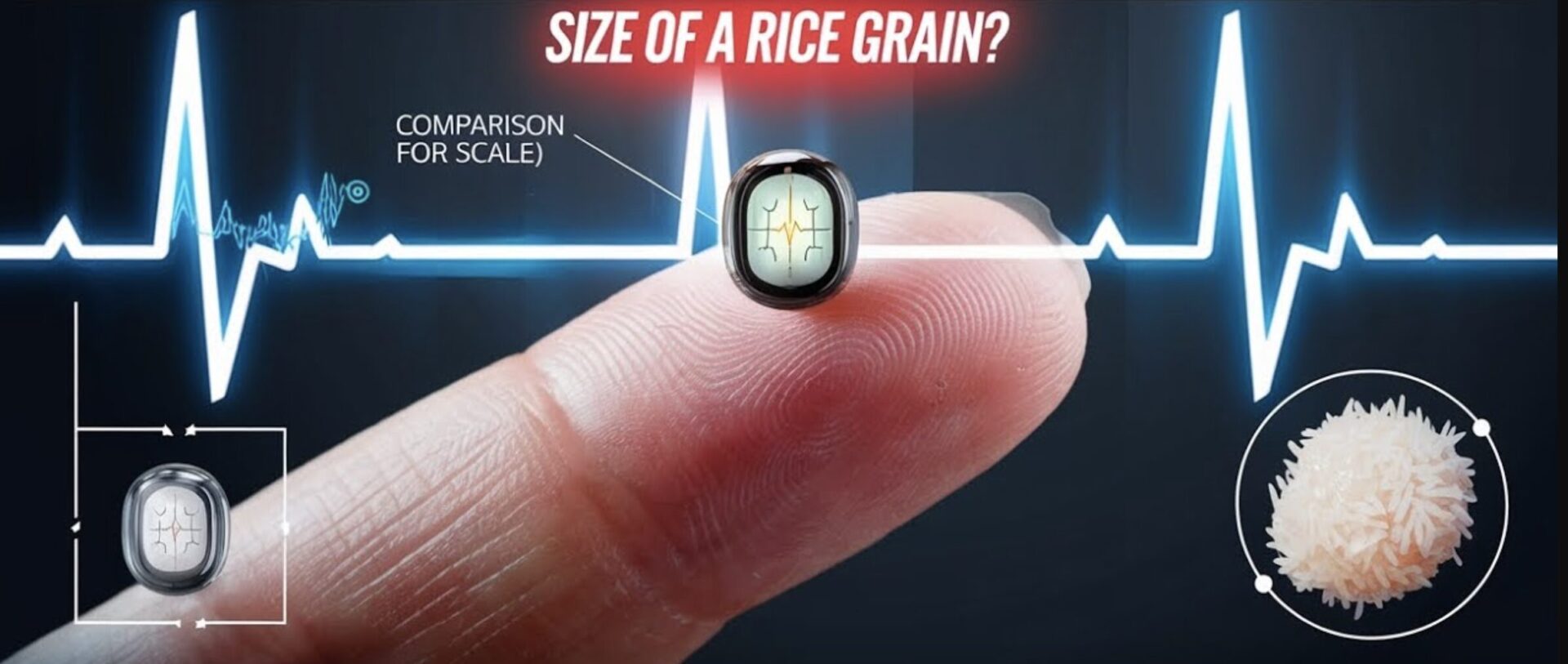Most people think of a pacemaker as a small box tucked under the skin, with wires snaking through blood vessels to the heart. But researchers at Northwestern University have invented something entirely different: a pacemaker smaller than a grain of rice—about 1.8 mm wide, 3.5 mm long, and only 1 mm thick—that can be injected directly onto the heart’s surface. No bulky batteries. No wires. And after it does its job, it simply dissolves inside the body, leaving behind nothing but healing tissue.
Musumeci Online – The Podcast. It is perfect for driving, commuting, or waiting in line!

Why We Needed a Tiny, Wireless, Biodegradable Pacemaker
Temporary Pacing in Newborns (and Adults Too).
About 1% of babies are born with congenital heart defects. After corrective surgery, these tiny hearts sometimes need extra electrical support for a week or so before they start beating normally on their own. Traditional temporary pacemakers involve sewing electrodes onto the heart muscle and running wires out through the chest to an external battery pack. When the heart recovers, doctors pull the wires and remove the device—an extra surgery that carries risks of infection, bleeding, and tissue damage.
Learning from Neil Armstrong’s Tragic Case.
Even the first man on the Moon wasn’t immune to these risks. In 2012, Neil Armstrong developed complications after bypass surgery and received a temporary pacemaker. When the wires were pulled, they caused internal bleeding that eventually led to his death. In that light, a device that disappears on its own could save lives by eliminating any need for a second procedure to remove hardware.
How the Rice-Grain Pacemaker Works
1. Powered by Body Fluids—Like a Simple Salt-Water Battery
Imagine making a battery in a school science class using two different metals—magnesium and iron—placed in salt water. The salty solution conducts electricity, causing a tiny flow of current between the metals. The rice-grain pacemaker uses this exact principle: when its two metal pads touch the body’s natural fluids (which act like the salt water), they generate just enough electrical energy to stimulate the heart.
Galvanic Cell Basics: The device’s electrodes—one made of magnesium, the other of iron—sit side by side on a flexible backing. As soon as those metals contact blood or interstitial fluid (the liquid that surrounds cells), they form a galvanic cell. A chemical reaction begins that produces a small electric current—just enough to prompt a heartbeat.
2. Activated by Infrared Light—No Wires Needed
To decide when to fire those pulses, the pacemaker relies on light signals rather than tangled wires or radio antennas. A soft, flexible patch worn on the patient’s chest detects the heartbeat. If it senses a pause or a heart rate below a safe threshold (for example, under 60 bpm), it shines pulses of infrared light toward the pacemaker.
Why Infrared? The same kind of light that makes a flashlight glow red through your palm can travel through skin, bone, and muscle. It’s completely harmless and reaches deep enough to activate the tiny light-sensitive switch on the pacemaker. Each flash “turns on” the rice-grain device, causing it to send a quick electrical jolt to the heart muscle—restoring a steady rhythm.

3. Dissolves When It’s No Longer Needed
The entire pacemaker is made of biocompatible, bioresorbable materials—meaning all its parts are designed to break down safely in the body’s fluids. Just like dissolvable stitches that vanish after a wound heals, this pacemaker starts to disappear after about seven days (the typical time a newborn’s heart needs support). By varying the thickness and composition of the layers, engineers precisely tune how long it lasts before fully dissolving into harmless byproducts.

Benefits Compared to Traditional Pacemakers
1. Minimized Trauma & Surgical Risk:
- Traditional Approach: Surgeons implant leads onto the heart during open-chest surgery, then tunnel wires out through the skin to connect to a bulky external box. Removing those leads later can tear heart tissue, cause bleeding, or introduce infection.
- Rice-Grain Pacemaker: Inserted via a tiny needle (percutaneous injection) and stuck directly onto the heart’s surface. No wires exit the chest, so no second surgery or risk of pulling on scar tissue when the device is removed—it just dissolves.
2. Ideal for Tiny Hearts:
- Newborn babies have very small, fragile hearts. Even miniaturized versions of standard pacemakers are too large or stiff for their delicate tissues. The rice-grain pacemaker’s dimensions (1 mm thick!) make it gentle enough for neonatal use.
3. Multiple Devices for Better Synchronization:
- Because each pacemaker is so small, cardiac teams can deploy several devices across different regions of the heart. This enables more sophisticated pacing—imagine an orchestra conductor guiding each section with precision. In certain arrhythmias (irregular rhythms), doctors could activate distinct zones independently to restore coordinated contractions.
4. Reduced Hospital Stays and Costs:
Without the need for a second procedure to remove hardware and with less risk of complications, babies and adults recover faster, spend fewer days in intensive care, and require fewer follow-up surgeries. Over time, those savings add up—just like buying a high-efficiency appliance that costs more upfront but lowers utility bills year after year.
Step-by-Step: Injecting and Activating the Device
1. Percutaneous Injection: During the corrective heart surgery (or via a minimally invasive procedure), the surgeon uses a syringe to place the rice-grain device on the epicardial (outer) surface of the heart. The device’s soft, flexible design allows it to conform snugly to the moving tissue—like a small sticker that flexes with every beat.
2. Applying the Chest Patch: A lightweight, wearable patch is positioned on the baby’s chest. This patch contains a tiny sensor for monitoring heartbeat and a small infrared LED (light-emitting diode) for sending activation pulses.
3. Monitoring & Pacing: If the patch detects an irregular heartbeat—say, a pause longer than one second or a drop below the pre-set minimum (e.g., 60 bpm)—it automatically triggers the infrared LED. The light pulses penetrate through the skin and tissues, reaching the implanted pacemaker. Each flash “turns on” the device’s switch, allowing the galvanic cell to send a short electrical pulse to the heart muscle. These pulses come at the normal target rate (for example, 120 bpm for a newborn).
4. Natural Dissolution: After about a week (the timeframe doctors designed via material thickness), the device’s layers degrade into harmless traces—similar to common dissolvable stitches. There’s no need to reopen the chest or tug on delicate tissue. The body’s fluids simply absorb the materials, and the site heals naturally.

Real-World Testing: From Animals to Human Hearts
Before trying this pacemaker in living patients, scientists rigorously tested it in large and small animal models—mice, rats, pigs, and dogs. These studies showed that:
- Reliable Pacing: Even though the device is smaller than a grain of rice, it delivers the same level of stimulation as a full-size temporary pacemaker.
- Safe Dissolution: After the device’s functional window, no harmful residues remained, and heart tissue showed no signs of inflammation or scarring from leftover materials.
- Light-Penetration Efficacy: Infrared pulses from the chest patch consistently activated the pacemaker through real tissue layers, mirroring the “flash through your palm” demonstration.
Additionally, researchers performed lab tests on human donor hearts (that were no longer viable for transplant) to confirm that the infrared activation and galvanic cell design would work in human anatomy. All signs point toward safe translation into first-in-human trials, likely within the next two to three years.
A Brighter Future for Heart Patients
Eliminating Second Surgeries. By bypassing the need to remove hardware, families face fewer hospital visits—and babies avoid the stress of a second operation. That’s peace of mind when every hour counts.
Lower Infection Risk. No wires piercing the skin means fewer entry points for bacteria. Infections are among the most dangerous postoperative complications; reducing that risk can be lifesaving.
Adaptable to Other Implants. Because of its tiny form factor, the pacemaker could attach to other devices—such as transcatheter heart valves or vascular grafts. If a patient develops a conduction block after implanting a new valve, the rice-grain pacemaker could be activated only as long as needed, then vanish.
Building Blocks for Bioelectronic Medicines. The same strategy—using body-fluid batteries, light-activated switches, and dissolvable materials—could expand into other therapies. Imagine:
- Nerve-Regenerating Implants: Tiny devices that send low-level pulses to injured peripheral nerves, guiding them to regrow. After the nerve heals, the implant disappears.
- Bone-Healing Stimulators: Rice-grain stimulators that energize bone cells in a fracture, speeding recovery without bulky external braces.
- Wound-Healing Patches: Small patches that send timed pulses or drugs to a chronic wound, then dissolve, leaving only regenerated skin.
Explaining the Numbers with Everyday Analogies
Size Comparison: At 1.8 mm by 3.5 mm by 1 mm, the pacemaker is roughly equivalent to a sesame seed’s volume. If you imagine a grain of rice 30 times longer than a sesame seed, this device would fit comfortably on its surface.
One-Percent Statistic: When doctors say “1% of newborns have heart defects,” picture a school auditorium with 200 students—about two children in that group will be born with a congenital heart issue requiring special care.
Dissolution Time (Seven Days): Think of how dissolvable stitches feel in your mouth if you accidentally bite them; within a week, they’re gone without you noticing. The pacemaker’s layers are engineered to behave the same way in heart tissue.
Tiny Device, Huge Impact
By reinventing the pacemaker as a rice-grain-sized, wireless, and biodegradable implant, scientists have rewritten what’s possible in cardiac care. Newborns no longer need to fear a second surgery to remove pacing wires, and adults recovering from heart procedures may skip weeks of recovery. More broadly, this discovery illustrates the future of medicine: devices that work inside the body for just as long as they need to, then vanish—leaving patients healthier, happier, and free from the burden of extra surgeries or foreign objects.
As researchers move toward human trials, the promise is clear: a tiny, light-activated spark inside a dissolvable package that keeps hearts beating and families breathing easier.


Leave a Reply